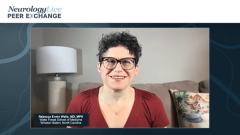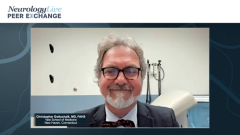
Oral Agents for Preventative Migraine Treatment
A key opinion leader discusses the use of oral agents for the preventive treatment of migraine.
Episodes in this series

Jessica Ailani, MD: Chris, why don’t you talk to us a little bit about gepants for preventive treatment of migraine?
Christopher Gottschalk, MD, FAHS: I’ll start with a little bit of background. The first phase of therapies that targeted CGRP [calcitonin gene-related peptide] were in fact agents in this class. Some oral agents were CGRP receptor antagonists. This is going back over 10 years ago now. The initial focus of those trials was all on acute therapy, so looking for a new class of new abortive therapies different from triptans based on the evidence that CGRP levels are increased during acute attacks of migraine and cluster headache, and that, in fact, infusing the CGRP into susceptible patients with migraine can trigger an episode. So, with all that, the idea of blocking its receptor was an understandable initial target.
The problem was with those initial drugs that several of them produced liver abnormalities and liver toxicity so most of those programs were abandoned. Then came the era of using monoclonal therapies to target receptors or even ligand as a different way of targeting that system and were extremely successful. I think it really carried along the momentum and enthusiasm of CGRP as a target again which led to the development of these newer gepants. Which, again, are things that target the receptor directly.
In the case of the 2 drugs that were initially approved, rimegepant or Nurtec, and ubrogepant or Ubrelvy, those were initially approved as acute abortive therapies and clearly provide benefit for many patients, often have lower side effects. But lo and behold, the second of those to be approved, rimegepant, found in its longer term exposure trials, where they were allowing patients to take this drug as much as every other day and sometimes more if needed than patients who were taking the drug consistently every 2 to 3 days, found that overall they had fewer headache days in a month on average. That has led to the approval of rimegepant as a preventive therapy. Along those lines, there are a couple of agents which were being studied specifically for migraine prevention, oral agents that block the receptor, and the most recent of those is a paper, whose lead author happens to have been Dr Jessica Ailani, giving us atogepant [Qulipta] as a daily preventive therapy.
Again, along with everything else, the fact that we are in an era where we have migraine-specific and target-specific therapies that can provide either acute or preventive relief for patients, and now we have the flexibility of a range of options from a pill every day, to a shot every month, to an infusion every quarter. All of these options provide more ways to help patients based on their individual needs and goals.
The remarkable thing is that for, let’s say, atogepant, the most recent addition to the group, that you’re again talking about significant improvement in their overall status, reduction in the number of days of migraine, or an improvement in the 50% responder rates that are as much as twice that of placebo. Even with this drug, atogepant, we also have dose flexibility. There’s a 10-, a 30-, a 60-milligram dose, so something that can be adjusted based on either their medical history or their side effect profile. But it’s an important option particularly because, as we’ve mentioned already in this discussion, there are patients who say, “I’m sorry but an injection is just not an option for me or I get injection site reactions and I’m not happy about that.” So we have various ways of approaching the individual needs of patients, and this latest addition I think is a remarkable one.
I’ll also comment that 1 of the beautiful things about the ADVANCE trial, the trial that led to the approval of atogepant, is that it was 1 of the better studies to focus on the direct impacts of this treatment on quality of life. Several different standardized validated measures like the migraine-specific quality of life scale and a diary that looked at day-to-day disability clearly showed significant benefits of all 3 doses on disability and function over time in a careful way. And I think in the long run that’s the thing that matters to us most, right? We are mandated by the FDA [Food and Drug Administration] to do preventive trials that measure mean migraine days and then reduction, fine, but our day-to-day experience is much more focused on has this treatment improved your quality of life, has it improved your sense of control, does it mean that you’re able to function in the roles that matter to you more often. We now have solid data for this treatment, as much as any others, that say absolutely. We’re not just talking about numbers here. We’re talking about your experience. I think that matters a lot.
Jessica Ailani, MD: Thank you to our audience for watching this Neurology Live® Peer Exchange. I hope that you’ve enjoyed watching this program as much as we’ve enjoyed spending this time together. If you have enjoyed this content, please subscribe to our e-newsletters to receive upcoming Peer Exchanges and other great content right in your inbox.
Transcript edited for clarity.
Newsletter
Keep your finger on the pulse of neurology—subscribe to NeurologyLive for expert interviews, new data, and breakthrough treatment updates.






























